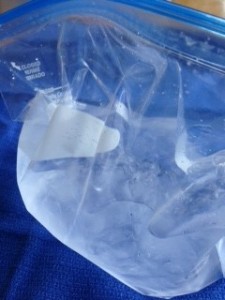Swelling After Cosmetic Surgery
February 4th, 2014
Swelling is a normal part of any surgery. For some patients, the most distressing aspect of swelling is the temporary weight gain due to the extra fluid. This temporary fluid is normal and will pass with time, usually 2-3 days. However, minor swelling may remain and disguise the ultimate result for upwards of 6 months for some types of cosmetic surgery.
Why does swelling happen? The process of tissue swelling begins to occur immediately when surgery is started. Initially it begins next to the edge of the incised skin. The tissues adjacent to the incision also begin to swell. These are the first steps in the stages of normal healing. Swelling continues as tissues are dissected to allow implant placement (breast enlargement), to allow fat removal (liposuction), or to allow skin and muscle tightening (facelift). As I complete surgery, allowances must be made for swelling as the final sculpting is completed. The process of swelling continues as patients recover. Maximum swelling is usually between 48 and 72 hours after surgery. This swelling will extend beyond the surgery site to involve adjacent areas. In the case of breast enlargement, swelling will extend onto the chest, back and abdomen. Patients may also notice swelling in distant areas, such as hands and feet, areas well removed from the surgical site
When will this go away? Swelling will begin to pass out of your body 2 to 3 days after surgery. See tips to reduce swelling. It is naturally excreted in your urine. Initial resolution is rapid, with the vast majority of swelling gone in four to six weeks. Complete resolution of any remaining swelling may take as long as six to twelve months. Waiting this long to see a final result is frustrating to many patients, this is simply part of scar maturation and the physiology of internal healing. So once again, patience is a virtue!
Ice Packs Safety After Cosmetic Surgery
January 29th, 2014
I am finding that we receive many of the same questions coming into our blog regularly. How about using ice packs to control pain after cosmetic surgery? This answer is not straight forward, because the answer is a “qualified†yes. Using ice bags after surgery is a commonly recommended practice to reduce post-operative pain, swelling and bruising. The application of cold temperature at or just above freezing temperature (32F or 0C) is an effective and safe way to help in the initial healing and swelling phase. I recommend that patients use ice sealed in plastic bags, such as Ziploc style bags, filled with ice and water for this purpose. It is very important to make sure there is water (liquid) in the bag, because this assures that the temperature of the ice is at or just above the freezing temperature of water.
My patients report that nothing feels better than the cooling effect of ice after breast enlargement surgery. Besides feeling good, it helps to reduce the need for narcotic pain relievers. However, we must also be careful with the temperature of the cold application. The same risks are present regarding both heat and cold. Similarly, patients are unable to feel warning signs for potential risk of damage due to the improper use of cold packs.
Ice, gel pads and bagged frozen vegetables applied directly from the freezer will be well below freezing, thus being too cold and are not suitable. If these are applied to the skin, which is numb and susceptible to injury, frostbite and scarring can result. Therefore, I do not recommend their use. One important exception to any ice application after cosmetic surgery is following fat grafting procedures, because the cold is particularly detrimental to the survival of the grafts. For this reason we do not recommend the use of ice after natural breast enlargement or facial rejuvenation using the fat grafting technique.


